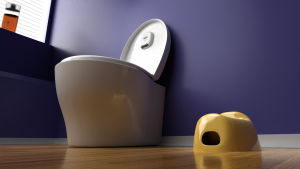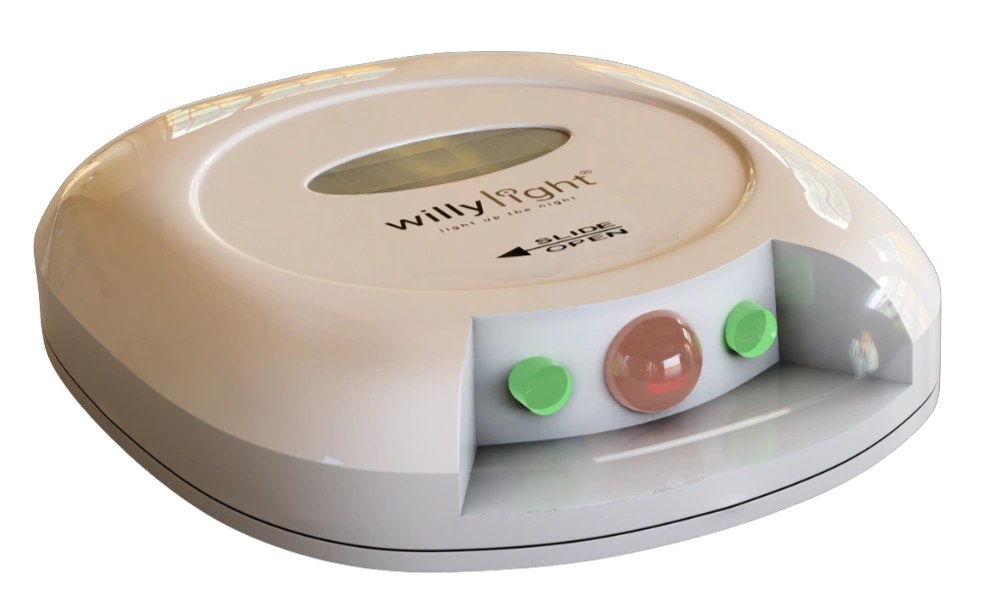
The potty vs big toilet decision represents one of the most crucial choices in toilet training, yet many parents don’t realize they’re making it. The transition dilemma affects thousands of families: children who master potty chairs but struggle to move to regular toilets, creating months of additional training and frustration.
Research shows that direct-to-toilet training with proper aids consistently produces faster, more successful outcomes with fewer transition struggles. When children learn on the same toilet they’ll use long-term, they develop authentic bathroom skills, proper etiquette habits, and real-world independence from day one.
This guide reveals why the direct-to-toilet approach with quality aids outperforms traditional potty training, helping you skip the common transition struggles that derail many families’ toilet training success.
The Martinez family thought they had toilet training figured out. Their 3-year-old son Diego had been using his colorful, musical potty chair successfully for three months. He rarely had accidents, could sit independently, and even cleaned himself afterward.
But when they tried to transition Diego to the family toilet, everything fell apart. He was afraid of the height, couldn’t balance properly, complained about the cold seat, and refused to use bathrooms outside their home. What seemed like toilet training success suddenly revealed itself as elaborate potty chair mastery – not real toilet independence.
“We realized we had trained him to use one specific piece of equipment in one specific location,” explains father Carlos Martinez. “We thought we were almost done, but we were actually starting over.”
The Martinez family discovered what many parents learn too late: the transition dilemma creates more problems than it solves. When they finally switched to direct-to-toilet training with proper aids, Diego mastered real bathroom independence in just two weeks.
This story illustrates why the potty vs big toilet choice matters far more than most parents realize, and why understanding the transition challenges can save months of frustration.
Understanding the Transition Dilemma
What Is the Transition Dilemma?
The transition dilemma occurs when children master potty chairs but struggle to move to regular toilets. This creates a second training period where families must:
- Overcome fear and resistance to using “big” toilets
- Retrain physical positioning and balance skills
- Address comfort and security concerns
- Navigate public restroom challenges
- Manage regression and accidents during transition
Why Transitions Fail
Physical differences: Potty chairs and toilets require completely different body positioning, balance, and muscle engagement
Psychological associations: Children develop strong attachments to familiar potty chairs and resist unfamiliar toilets
Skill gaps: Potty chair success doesn’t translate to toilet seat management, proper positioning, or toilet etiquette understanding
Comfort factors: Height differences, cold seats, echoing sounds, and unfamiliar environments create anxiety
The Hidden Costs of Transition Struggles
When transitions fail, families experience:
- Extended training periods (often 3-6 additional months)
- Increased resistance and power struggles
- Public restroom avoidance and social limitations
- Regression in other bathroom skills
- Family stress and ongoing conflicts over bathroom behavior
The Case for Direct-to-Toilet Training
What Is Direct-to-Toilet Training?
Direct-to-toilet training means starting toilet training on regular toilets from day one, using appropriate aids for safety, comfort, and success. Children learn authentic bathroom skills on the equipment they’ll use long-term.
Why Direct-to-Toilet Works Better
No transition required: Children develop skills on their permanent toilet setup Real-world preparation: Immediate familiarity with all toilets, including public restrooms Complete skill development: Learning includes seat management, proper positioning, and bathroom etiquette Authentic independence: Skills transfer immediately to any bathroom situation Faster overall timeline: Eliminates the 3-6 month transition period most families experience
Success Rate Comparison
Studies and real-world outcomes show:
- Potty chair method: 70% of children require 2-6 months for successful transition
- Direct-to-toilet method: 95% of children achieve complete independence without transition struggles
- Overall timeline: Direct-to-toilet typically 2-4 months faster than potty-to-toilet progression
Breaking Down the Approaches
Traditional Potty Chair Method
The process:
- Introduce standalone potty chair
- Establish routine using only the potty chair
- Celebrate potty chair mastery
- Attempt transition to big toilet
- Manage transition challenges and resistance
- Eventually achieve toilet independence
Timeline: Typically 6-12 months total
Challenges:
- Two separate learning processes
- Equipment dependence in early months
- Transition resistance and fear
- Public restroom difficulties
- Limited real-world application
Direct-to-Toilet Method
The process:
- Set up big toilet with appropriate safety and comfort aids
- Begin toilet training on regular toilet from day one
- Build skills progressively on permanent equipment
- Achieve complete bathroom independence
- Transfer skills immediately to any bathroom
Timeline: Typically 3-6 months total
Advantages:
- Single learning process
- Real-world skill development
- No transition period required
- Immediate public restroom competence
- Complete bathroom habit formation
Essential Aids for Direct-to-Toilet Success
Safety and Comfort Foundations
Quality toilet seat inserts:
- Secure attachment to prevent slipping
- Comfortable sizing for your child’s proportions
- Easy-clean materials and design
- Stable positioning during use
Sturdy step stools:
- Anti-slip base for safety
- Appropriate height for your toilet
- Wide platform for stability
- Easy positioning and storage

Skill-Building Tools
Visual feedback systems: Tools that teach proper bathroom etiquette and behavior from the beginning
The Willy Light exemplifies this approach perfectly – providing immediate visual feedback about toilet seat position and proper bathroom courtesy, helping children develop complete bathroom responsibility from day one.
Target practice aids (for boys): Help develop accuracy skills on the actual toilet they’ll use long-term
Hygiene support tools: Appropriate toilet paper, wipes, and handwashing setup at child height
Environmental Modifications
Temperature control: Addressing cold seat concerns with padded inserts or seat warmers Lighting improvements: Ensuring adequate lighting for confidence and safety Sound management: Soft-close toilet seats and noise reduction for sensitive children Accessibility enhancements: Easy-reach supplies and child-friendly bathroom organization
Age-Specific Direct-to-Toilet Strategies
Ages 18-24 Months: Foundation Building
Approach: Introduction and familiarity without pressure
- Allow bathroom observation and exploration
- Introduce toilet seat insert for trial sits
- Begin bathroom routine establishment
- Read toilet training books focusing on big toilet use
Key tools: Basic toilet seat insert, low step stool, observation time
Ages 2-2.5 Years: Active Preparation
Approach: Skill building and readiness assessment
- Regular practice sits with clothes on
- Introduction to bathroom sequence and expectations
- Visual cue systems to support learning
- Comfort and confidence building
Key tools: Quality seat insert, visual feedback systems, comfort enhancements
Ages 2.5-3 Years: Intensive Training
Approach: Full toilet training implementation
- Complete bathroom routine establishment
- Etiquette and responsibility training
- Independence building with ongoing support
- Problem-solving and skill refinement
Key tools: Comprehensive aid setup, etiquette training tools, consistency support
Ages 3+ Years: Advanced Independence
Approach: Mastery and complete self-sufficiency
- Public restroom confidence building
- Advanced etiquette and consideration skills
- Complete independence in all bathroom tasks
- Long-term habit reinforcement
Key tools: Advanced visual feedback, independence verification systems

Gender Considerations for Direct-to-Toilet Training
Boys: Complex Skills Require Real-World Practice
Boys benefit significantly from direct-to-toilet training because: Multi-position requirements: Learning both sitting and standing positions on actual toilet equipment Aim development: Practicing accuracy skills on the toilet they’ll use permanently Etiquette essentials: Understanding toilet seat management from the beginning Spatial awareness: Developing real-world bathroom spatial skills
Essential aids for boys:
- Secure toilet seat inserts that handle position changes
- Visual feedback systems like the Willy Light for immediate etiquette learning
- Target practice aids designed for regular toilets
- Step stools that support both sitting and standing positions
Girls: Confidence and Independence Focus
Girls typically adapt well to direct-to-toilet training with emphasis on: Comfort and security: Ensuring physical comfort on larger toilet seats Hygiene mastery: Learning proper cleaning techniques in real bathroom environment Independence building: Developing complete self-sufficiency skills Public restroom preparation: Immediate familiarity with standard toilet setups
Effective aids for girls:
- Comfortable, secure toilet seat inserts
- Appropriate step stools for complete independence
- Hygiene support tools at appropriate height
- Confidence-building visual and educational aids
Common Direct-to-Toilet Concerns and Solutions
“My Child Is Too Small for a Big Toilet”
The concern: Physical size differences make toilet use unsafe or uncomfortable
The reality: Proper aids eliminate size issues while building real-world skills
- Quality seat inserts provide appropriate sizing and security
- Sturdy step stools ensure safe positioning and independence
- Comfort modifications address temperature and texture concerns
The solution: Invest in quality aids rather than avoiding real toilet use
“Potty Chairs Seem Easier and More Convenient”
The concern: Potty chairs appear simpler and require less setup
The reality: Convenience now creates complications later
- Potty chairs require emptying, cleaning, and maintenance
- Transition periods often take longer than direct training
- Real bathroom skills need development eventually
The solution: Front-load the setup investment for long-term simplicity
“What About Travel and Public Restrooms?”
The concern: Children trained on home toilets won’t manage different bathrooms
The reality: Direct-to-toilet training creates better public restroom success
- Children familiar with standard toilets adapt easily to variations
- Seat inserts can travel for consistency when needed
- Real-world skills transfer immediately to any bathroom
The solution: Practice with various toilets builds confidence and adaptability
“My Child Prefers the Potty Chair”
The concern: Children resist toilet use after potty chair familiarity
The reality: Preference often indicates incomplete transition rather than true choice
- Children may fear toilet use due to inadequate aids or support
- Proper setup and gradual introduction overcome resistance
- Long-term benefits outweigh short-term preference challenges
The solution: Gradual transition with excellent aids and consistent support
Making the Switch: From Potty Chair to Direct-to-Toilet
If You’ve Already Started with a Potty Chair
Step 1: Assessment (Week 1)
- Evaluate current potty chair skills and confidence
- Identify specific concerns about toilet use
- Gather appropriate aids and modifications
- Plan gradual introduction strategy
Step 2: Introduction (Week 2-3)
- Set up toilet with all necessary aids
- Begin with clothed practice sits for familiarity
- Maintain potty chair availability without pressure
- Focus on comfort and confidence building
Step 3: Transition (Week 4-6)
- Begin actual toilet use for specific bathroom functions
- Gradually reduce potty chair dependence
- Address fears and resistance with patience and support
- Celebrate toilet successes enthusiastically
Step 4: Mastery (Week 7+)
- Eliminate potty chair completely
- Focus on independence and skill refinement
- Practice public restroom use
- Establish long-term bathroom habits
Timeline Expectations for Switching
Motivated children: 2-4 weeks for complete transition Resistant children: 6-8 weeks with consistent, patient approach Highly attached children: 8-12 weeks requiring creative strategies and extra support
Success Stories: Direct-to-Toilet Victories
The Chen Family: Avoiding the Transition Trap
After struggling with their older daughter’s potty-to-toilet transition, the Chen family chose direct-to-toilet training for their son Michael.
“We invested in a really good toilet seat insert and the Willy Light for immediate feedback,” explains mother Lisa Chen. “Michael learned proper toilet use, etiquette, and consideration all at once. When we took him to restaurants or friends’ houses, he used their bathrooms confidently from the beginning.”
Result: Complete toilet independence in 10 weeks with no transition period required.
The Wilson Family: Making the Switch Successfully
The Wilson family realized their potty chair approach wasn’t working when their 3.5-year-old daughter refused to use any toilet except her special potty.
“The switch seemed scary, but it was actually easier than we expected,” notes father David Wilson. “Once Emma had proper aids and felt secure on the big toilet, she preferred it. She felt like such a ‘big girl’ using the same bathroom as everyone else.”
Result: Successful transition in 6 weeks, followed by immediate public restroom confidence.

Cost-Benefit Analysis: Potty Chair vs Direct-to-Toilet
Potty Chair Method Costs
Equipment: Potty chair ($20-80) + cleaning supplies + transition aids ($50-100) Time: 6-12 months total training time Hidden costs: Extended diaper purchases, cleaning time, transition struggles Opportunity costs: Delayed independence, limited social opportunities
Total investment: $70-180 + 6-12 months + ongoing challenges
Direct-to-Toilet Method Costs
Equipment: Quality toilet seat insert ($30-60) + step stool ($20-40) + visual aids ($50-150) Time: 3-6 months total training time
Benefits: Immediate real-world skills, no transition period, complete independence Long-term value: Equipment usable for years, skills transfer immediately
Total investment: $100-250 + 3-6 months + immediate independence
The Clear Winner
Direct-to-toilet training costs slightly more upfront but saves significantly in time, effort, and long-term success. The elimination of transition struggles alone justifies the initial investment.
Expert Recommendations for 2025
Choose Direct-to-Toilet If:
- You want the fastest overall timeline
- Your child shows appropriate readiness signs
- Public restroom use is important for your family
- You prefer single-phase learning processes
- Long-term independence is the priority
Consider Potty Chair Only If:
- Your child has specific physical limitations requiring modified equipment
- Extreme toilet fear requires gradual desensitization
- Medical professionals recommend modified approach
- Temporary housing situations limit toilet access
Make the Choice Based on Your Child’s Needs
The best approach depends on your individual situation, but research strongly favors direct-to-toilet training for most families. When you provide proper aids and support, children develop authentic bathroom skills faster and more completely.
Skip the Transition, Embrace Success
The potty vs big toilet choice shapes your entire toilet training experience. While potty chairs seem convenient initially, they often create more problems than they solve through transition struggles and delayed real-world skill development.
Direct-to-toilet training with proper aids consistently produces faster, more complete success. When children learn on the equipment they’ll use permanently, they develop authentic independence, proper etiquette, and immediate transferable skills.
Don’t let the transition dilemma derail your toilet training success. Choose the approach that builds real-world bathroom competence from day one, supported by quality aids that ensure safety, comfort, and comprehensive skill development.
Your child deserves to learn bathroom skills that work in every situation, with every toilet, from the very beginning. Make the choice that sets them up for immediate and lasting success.
For more guidance on toilet training success, explore our related articles on choosing the right readiness timing, using visual cues effectively, teaching proper etiquette, and selecting effective training aids.




